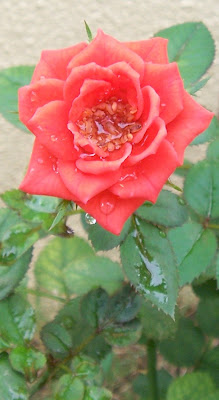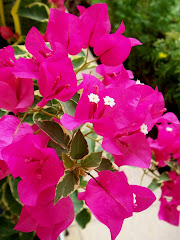Growing Zinnia is said to be
easy; "No flowers are easier to grow than zinnias - just plant, stand back and watch them grow into cheerful, brilliantly colored blooms perfect for cutting. The red and bright-pink varieties are especially attractive to butterflies." - quote eHow,
http://www.ehow.com/how_6794_grow-zinnias.html
Zinnias need three things to survive: sunny spot, dirt, and some water. If you want your zinnias to thrive, they'll need lots of sun, good soil, and regular water. Zinnias are not particular to soil, are drought resistant and has disease resistance. Zinnias member of the large Aster family of plants, originate from Mexico and were brought to Europe in 1613. They are named after a medical professor, Johann Gottfried Zinn.
I bought 2 black-bags of Zinnias, one (Ferrari) red, 'Heartland Red', and the other pink from USJ nursery, and transplanted into a 16" shallow terracotta pot. The same pot once housed Bluewings-Torenias. Perhaps we over-watered, because the red faded and died after 3 days from transplanting. It is placed to face west for full 5-6 hours noon-sun; protected from heavy downpour from the roof of porch. Our madagascar perinwinkle (catharanthus roseus) and yellow flower (still think it's Kerria) are indicators for pot-watering.
theflowerexpert advises: Zinnias are sensitive to root disturbance, so be especially careful when transplanting. If the taproot is disturbed, the double flowers may revert to single forms. The plants may also self-seed in the garden ... Most zinnias will bloom around three months to bloom from seed.
theflowerexpert advises: the growth is slow or leaves look pale green, fertilize with a soluble or controlled release fertilizer. Pinch young plants when they are 4-6inches high to promote compact, bushy growth. Good air circulation helps prevent onset of fungal leaf diseases. Deadhead spent flowers weekly if possible to promote additional bloom and maintain plant appearance.
http://www.theflowerexpert.com/flower-blog/default/2006/01/07/How-to-Grow-Zinnias.html?page=commentsIt is mentioned that Zinnias are annual plants and propagate through seedlings. So we see how this pot goes. Will keep you updated.
Update on Jan 3: It lasted less than a month since purchased and celebrated Christmas with us. After pulling out a decaying red Zinnia (in the background), pink Zinnia started to faded quickly and turned brown within a week. I think I should stick to single-flower Zinnias!




 Zinnias need three things to survive: sunny spot, dirt, and some water. If you want your zinnias to thrive, they'll need lots of sun, good soil, and regular water. Zinnias are not particular to soil, are drought resistant and has disease resistance. Zinnias member of the large Aster family of plants, originate from Mexico and were brought to Europe in 1613. They are named after a medical professor, Johann Gottfried Zinn.
Zinnias need three things to survive: sunny spot, dirt, and some water. If you want your zinnias to thrive, they'll need lots of sun, good soil, and regular water. Zinnias are not particular to soil, are drought resistant and has disease resistance. Zinnias member of the large Aster family of plants, originate from Mexico and were brought to Europe in 1613. They are named after a medical professor, Johann Gottfried Zinn.


















































